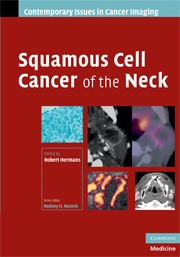Book contents
- Frontmatter
- Contents
- List of contributors
- Series Foreword
- Preface to Squamous Cell Cancer of the Neck
- 1 Introduction: epidemiology, pathology and clinical presentation
- 2 Radiotherapy and chemoradiotherapy of the head and neck
- 3 Surgery of the orocervical region
- 4 Laryngeal and hypopharyngeal cancer
- 5 Oral cavity and oropharyngeal cancer
- 6 Nasopharyngeal cancer
- 7 Neck and distant disease spread
- 8 Post-treatment imaging
- Index
- Plate section
- References
6 - Nasopharyngeal cancer
Published online by Cambridge University Press: 24 August 2009
- Frontmatter
- Contents
- List of contributors
- Series Foreword
- Preface to Squamous Cell Cancer of the Neck
- 1 Introduction: epidemiology, pathology and clinical presentation
- 2 Radiotherapy and chemoradiotherapy of the head and neck
- 3 Surgery of the orocervical region
- 4 Laryngeal and hypopharyngeal cancer
- 5 Oral cavity and oropharyngeal cancer
- 6 Nasopharyngeal cancer
- 7 Neck and distant disease spread
- 8 Post-treatment imaging
- Index
- Plate section
- References
Summary
Introduction
Nasopharyngeal carcinoma (NPC) is a unique malignancy showing a distinct racial and geographical distribution. The annual incidence rate (per 100 000 per year) in 1988–1992 ranged from < 1 among Caucasians to > 20 among southern Chinese male populations. The highest incidence rates are found in southern Chinese and this pattern persists in those who have emigrated. The incidence in high-risk populations rises after 30 years of age, peaks at 40–60 years and declines thereafter. This malignancy is more common in males, with a male to female ratio of 2.5:1. The time trend in the past was generally stable in most populations, but in recent years a gradual decline has been noted.
The etiology is based on the outcome of the interaction among genetic susceptibility, environmental factors (including chemical carcinogens) and the Epstein–Barr virus (EBV).
Anatomy of the nasopharynx
The nasopharynx is a fibromuscular sling hanging from the skull base. Its shape and volume resembles the terminal segments of the thumb. The sphenoid sinus and the basisphenoid form the roof of the nasopharynx (Fig. 6.1). The roof slopes posteriorly, with the basiocciput, atlas and axis forming the posterior wall. Anteriorly, it is contiguous with the choanae, with the posterior nasal margin forming the anterior limit. The lateral nasopharynx wall is formed from front to back by the medial pterygoid plate, the palatal muscles, the torus tubarius and the lateral pharyngeal recess (fossa of Rosenmuller). The soft palate separates the nasopharynx from the oropharynx.
- Type
- Chapter
- Information
- Squamous Cell Cancer of the Neck , pp. 94 - 113Publisher: Cambridge University PressPrint publication year: 2008



